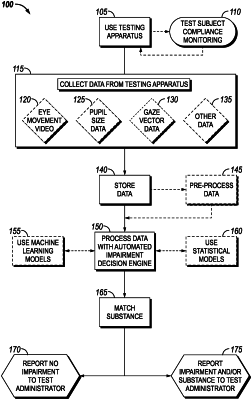| CPC A61B 5/163 (2017.08) [A61B 5/14517 (2013.01); A61B 5/4266 (2013.01); A61B 5/4845 (2013.01); A61B 5/7264 (2013.01)] | 27 Claims |

|
1. A system comprising:
a display;
a stimulus on the display;
a controller, wherein the controller is programmed to move the stimulus about the display;
one or more sensors, wherein the one or more sensors track eye movements and pupil size of a user due to movement of the stimulus or light conditions;
a dataset of impaired and sober individuals;
machine learning algorithms that are trained with the dataset of impaired and sober individuals;
a processor programmed to use the machine learning algorithms to analyze the eye movements and pupil size data;
a database of known test subjects;
wherein the processor is programmed to automatically identify the user based on eye measurement data if the user is contained within the database of known test subjects; and
wherein based on the automatic identification of the user the controller is programmed to administer certain tests that are most relevant to the user.
|
|
25. A system comprising:
a display;
a stimulus on the display;
a controller, wherein the controller is programmed to move the stimulus about the display;
one or more sensors, wherein the one or more sensors track eye movements and pupil size of a user due to movement of the stimulus or light conditions;
a dataset of impaired and sober individuals;
machine learning algorithms that are trained with the dataset of impaired and sober individuals;
a processor programmed to use the machine learning algorithms to analyze the eye movements and pupil size data;
an algorithm to determine if the user is following instructions during a testing process to determine if the user is being a non-compliant user; and
wherein the processor is programmed to notify a test administrator if the algorithm detects that the user is purposefully not following instructions during a testing process.
|
|
27. A system comprising:
a display;
a stimulus on the display;
a controller, wherein the controller is programmed to move the stimulus about the display;
one or more sensors, wherein the one or more sensors track eye movements and pupil size of a user due to movement of the stimulus or light conditions;
a dataset of impaired and sober individuals;
machine learning algorithms that are trained with the dataset of impaired and sober individuals;
a processor programmed to use the machine learning algorithms to analyze the eye movements and pupil size data; and
a random number generator, wherein the random number generator determines a location of the stimulus on the display.
|